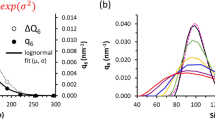Abstract
The coalescing behavior of gold nanoparticles was studied by employing molecular dynamics simulations based on a semi-empirical embedded-atom method. Investigations on the coalescing process of the faceted nanoparticles revealed that at relatively low-temperatures, plastic deformation by slip motion was the main mechanism of coalescence, while near the melting point, coalescence was preceded by local fluid motion. Different initial configuration and coalescing temperature have a substantial influence on the coalescing behavior, making different final structures such as twinned face-centered cubic or amorphous nanoparticles.
Graphical Abstract







Similar content being viewed by others
References
Arcidiacono, S., Bieri, N., Poulikakos, D., Grigoropoulos, C.: On the coalescence of gold nanoparticles. Int. J. Multiph. Flow 30, 979–994 (2004)
Wang, J., Chen, S., Cui, K., Li, D., Chen, D.: Approach and coalescence of gold nanoparticles driven by surface thermodynamic fluctuations and atomic interaction forces. ACS Nano 10, 2893–2902 (2016)
Ingham, B., Lim, T.H., Dotzler, C.J., Henning, A., Toney, M.F., Tilley, R.D.: How nanoparticles coalesce: an in situ study of Au nanoparticle aggregation and grain growth. Chem. Mater. 23, 3312–3317 (2011)
de Heer, W.A.: The physics of simple metal clusters: experimental aspects and simple models. Rev. Mod. Phys. 65, 611 (1993)
Jensen, P.: Growth of nanostructures by cluster deposition: experiments and simple models. Rev. Mod. Phys. 71, 1695 (1999)
Buffat, P.-A., Flueli, M., Spycher, R., Stadelmann, P., Borel, J.-P.: Crystallographic structure of small gold particles studied by high-resolution electron microscopy. Faraday Discuss. 92, 173–187 (1991)
Reinhard, D., Hall, B.D., Ugarte, D., Monot, R.: Size-independent fcc-to-icosahedral structural transition in unsupported silver clusters: an electron diffraction study of clusters produced by inert-gas aggregation. Phys. Rev. B 55, 7868 (1997)
Reinhard, D., Hall, B.D., Berthoud, P., Valkealahti, S., Monot, R.: Size-dependent icosahedral-to-fcc structure change confirmed in unsupported nanometer-sized copper clusters. Phys. Rev. Lett. 79, 1459 (1997)
Reinhard, D., Hall, B.D., Berthoud, P., Valkealahti, S., Monot, R.: Unsupported nanometer-sized copper clusters studied by electron diffraction and molecular dynamics. Phys. Rev. B 58, 4917 (1998)
Baletto, F., Mottet, C., Ferrando, R.: Reentrant morphology transition in the growth of free silver nanoclusters. Phys. Rev. Lett. 84, 5544 (2000)
Baletto, F., Mottet, C., Ferrando, R.: Microscopic mechanisms of the growth of metastable silver icosahedra. Phys. Rev. B 63, 155408 (2001)
Foiles, S.M., Baskes, M.I., Daw, M.S.: Embedded-atom-method functions for the fcc metals Cu, Ag, Au, Ni, Pd, Pt, and their alloys. Phys. Rev. B 33, 7983 (1986)
Johnson, R.A.: Analytic nearest-neighbor model for fcc metals. Phys. Rev. B 37, 3924 (1988)
Plimpton, S., Crozier, P., Thompson, A.: LAMMPS-large-scale atomic/molecular massively parallel simulator. Sandia Natl. Lab. 18, 43 (2007)
Stillinger, F.H.: A topographic view of supercooled liquids and glass formation. Science 267, 1935–1939 (1995)
Sastry, S., Debenedetti, P.G., Stillinger, F.H.: Signatures of distinct dynamical regimes in the energy landscape of a glass-forming liquid. Nature 393, 554 (1998)
Steinhardt, P.J., Nelson, D.R., Ronchetti, M.: Bond-orientational order in liquids and glasses. Phys. Rev. B 28, 784 (1983)
ten Wolde, P.R., Ruiz-Montero, M.J., Frenkel, D.: Numerical evidence for bcc ordering at the surface of a critical fcc nucleus. Phys. Rev. Lett. 75, 2714 (1995)
Chushak, Y., Bartell, L.: Molecular dynamics simulations of the freezing of gold nanoparticles. Eur. Phys. J D At. Mol. Opt. Plasma Phys. 16, 43 (2001)
van de Waal, B.W.: No evidence for size-dependent icosahedral → fcc structural transition in rare-gas clusters. Phys. Rev. Lett. 76, 1083 (1996)
Lewis, L.J., Jensen, P., Barrat, J.-L.: Melting, freezing, and coalescence of gold nanoclusters. Phys. Rev. B 56, 2248 (1997)
Nam, H.-S., Hwang, N.-M., Yu, B.D., Yoon, J.-K.: Formation of an icosahedral structure during the freezing of gold nanoclusters: surface-induced mechanism. Phys. Rev. Lett. (2002). https://doi.org/10.1103/PhysRevLett.89.275502
Acknowledgments
This work was supported by Basic Science Research Program (2017R1A2B4012871), Leading Foreign Research Institute Recruitment Program (2013K1A4A3055679), and the Priority Research Centers Program (2009-0093814) through the National Research Foundation of Korea (NRF).
Author information
Authors and Affiliations
Corresponding author
Rights and permissions
About this article
Cite this article
Yun, K., Lee, J. & Nam, HS. Effect of Temperature on Coalescence Behavior of Unsupported Gold Nanoparticles. Electron. Mater. Lett. 15, 133–139 (2019). https://doi.org/10.1007/s13391-018-0090-6
Received:
Accepted:
Published:
Issue Date:
DOI: https://doi.org/10.1007/s13391-018-0090-6




